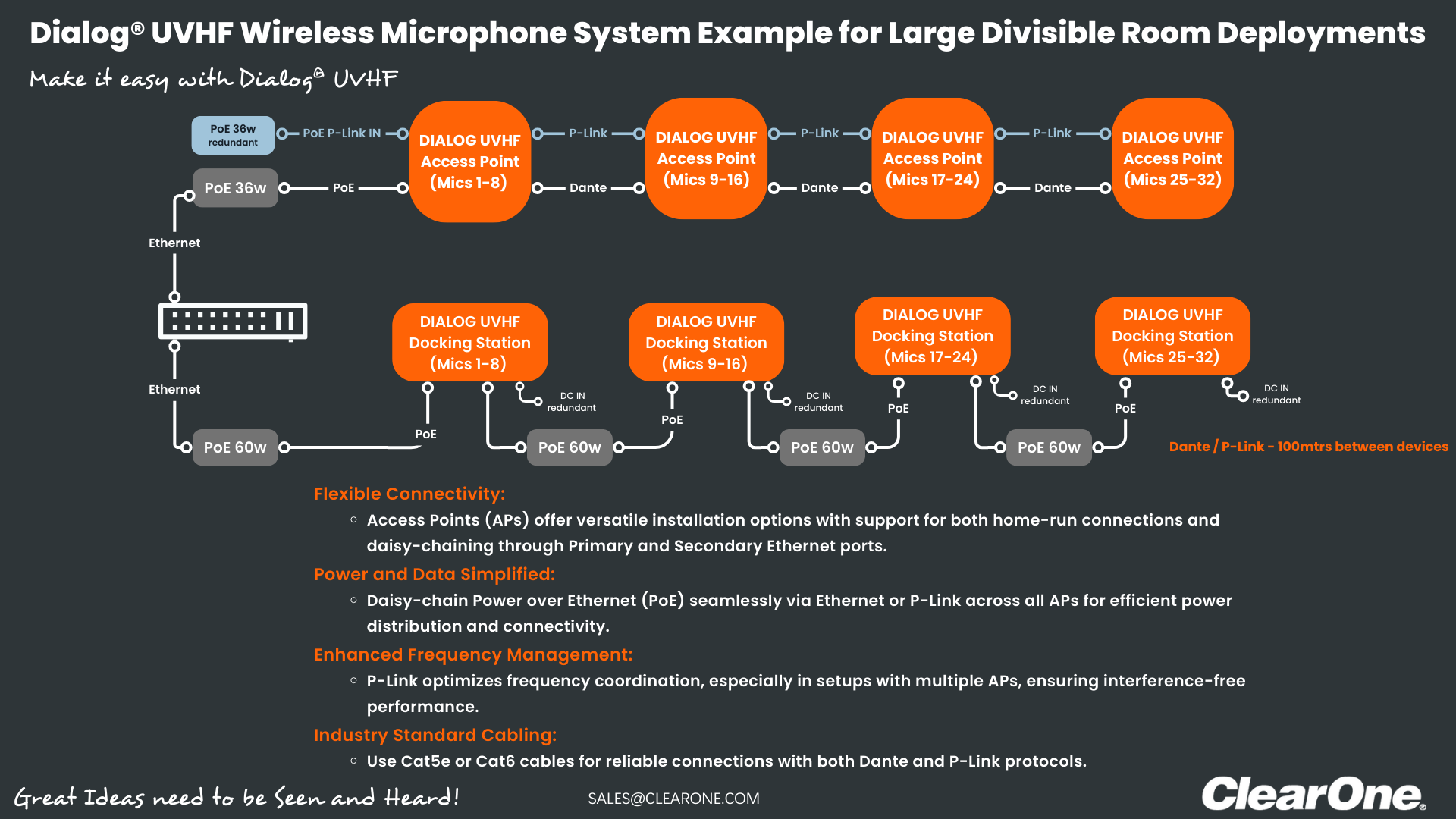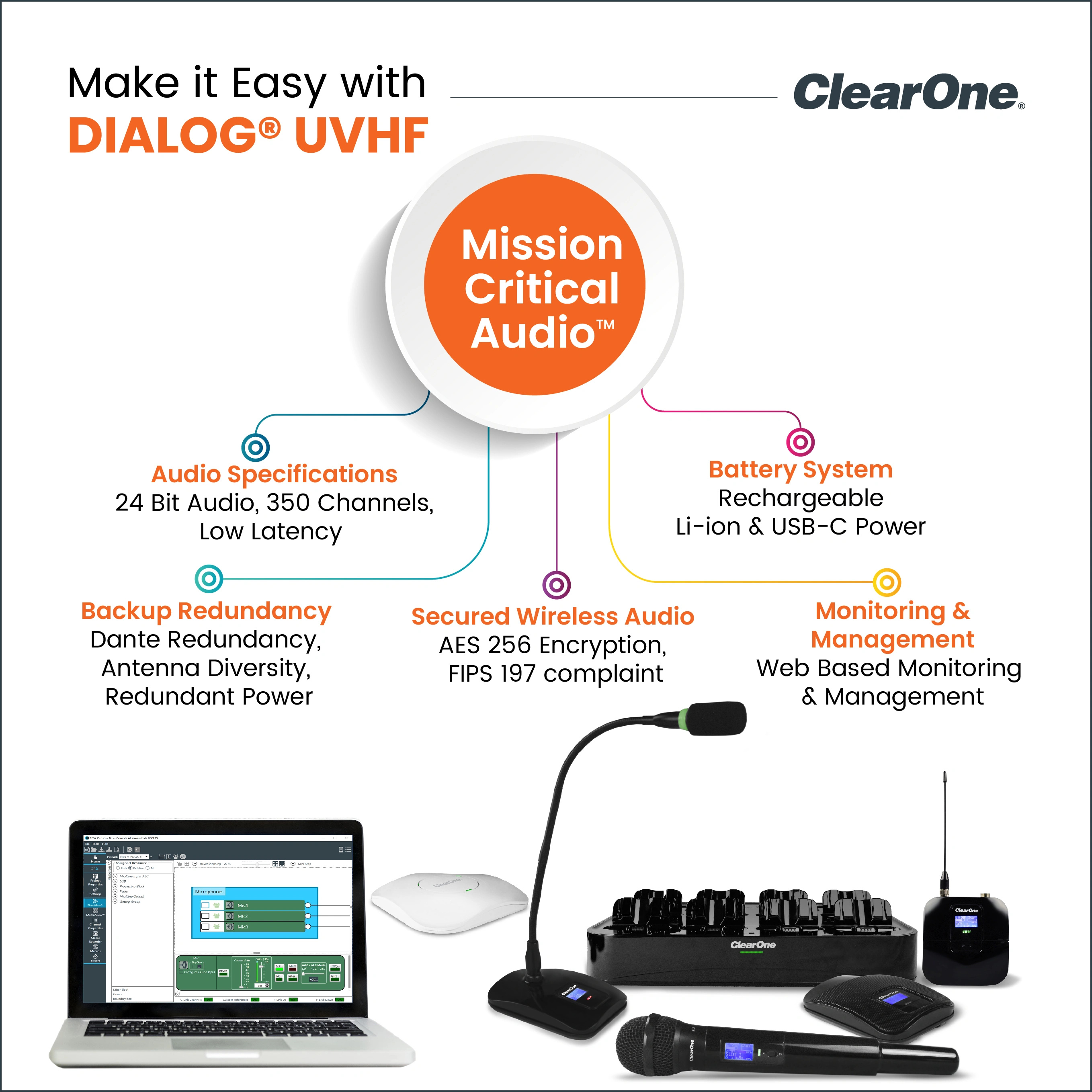Solving Wireless Audio Challenges in Large Rooms: Application Guide

Overview
Large hybrid-flexible (HyFlex) meeting rooms often require more than two to four wireless microphones, necessitating multiple wireless receivers. However, conventional systems lack inter-receiver communication, leading to frequency interference and suboptimal audio performance. The DIALOG® UVHF Wireless Microphone System addresses these issues with a purpose-built design, ensuring reliable and high-quality audio for demanding environments.
If you are an audio-visual system technician, you may have encountered:
-
Higher Latency and Echo Challenges:
-
Major wireless microphone systems, especially those relying on DECT-based designs create two major issues.
- Double Sound – Hearing the presenter twice: first through the direct acoustic sound path and then through the electronically amplified PA system. This issue arises from the higher latency of digital wireless microphones, particularly those using DECT-based systems. The inherent latency of DECT chipsets, originally designed for cordless phones, and baby monitors contributes significantly to this problem.
- Challenging the Echo Canceller – In hybrid video conferencing setups, delayed audio transmission from wireless microphones often results in residual echo, making it difficult for echo cancellers to function effectively. Many manufacturers recommend adding an input delay to the far-end receive signal to mitigate this, aligning it with the delayed microphone audio. However, this approach addresses the symptom rather than the root cause, leading to a compromised design. It impacts the echo canceller's non-linear processing (NLP), degrades full-duplex performance in the most common reverberant room designs, and adversely impacts local sound reinforcement, resulting in a suboptimal in-room and far-end audio experience.
-
Major wireless microphone systems, especially those relying on DECT-based designs create two major issues.
-
Interference with Multiple Wireless Microphones:
- Deploying four or more wireless microphones often results in interference as the microphones move around the vicinity of different access points (APs).
- This issue arises due to a lack of automatic frequency management between access points, as no communication is established between them in conventional systems.
DIALOG UVHF: Engineered to Solve These Issues
ClearOne is proud to introduce the Dialog® UVHF, designed to address these challenges with advanced capabilities. Multiple receivers can be seamlessly daisy-chained by leveraging the P-Link expansion bus, in addition to the Dante™ platform for audio, power, and control transport.
Low Latency for Natural Sound reproduction
- Wireless latency under 5 milliseconds and overall end-to-end latency under 9 milliseconds ensures natural reproduction with AES 256-bit encryption for security.
- This eliminates the need for complex delay compensation while preserving both local sound reinforcement and remote conferencing audio integrity.
Proprietary Link for Seamless Frequency Management
- A dedicated proprietary link between access points allows them to daisy-chain and communicate seamlessly. This is in addition to the Dante audio integration included.
- This ensures automatic frequency management, eliminating interference even when deploying multiple microphones across a large area.
The diagram below illustrates how the Dialog® UVHF simplifies cascading multiple units for Ethernet and power while integrating with Dante for robust performance. Furthermore, the Dialog® UVHF offers the most advanced wireless conferencing solution with power, antenna, and audio transport redundancy. It also features ultra-low latency and an ultra-wide bandwidth tuning range, ensuring exceptional audio quality and reliability for mission-critical environments.

A Game-Changer for Mission-Critical Environments






Please sign in or register for FREE
If you are a registered user on AVIXA Xchange, please sign in